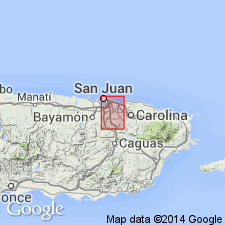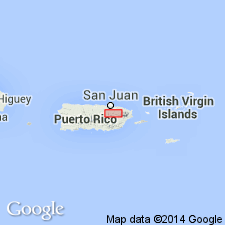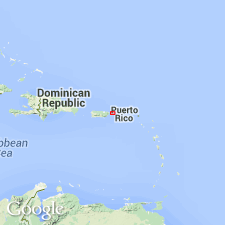
- Usage in publication:
-
- Figuera volcanics*
- Modifications:
-
- Redefined
- Dominant lithology:
-
- Breccia
- Tuff
- AAPG geologic province:
-
- Caribbean region
Summary:
The Figuera formation of Meyerhoff and Smith (1931) is here redefined the Figuera volcanics. Consists of mauve to greenish hornblende andesite breccia, flow rock, tuff, and vitrophyre with lenticular calcareous beds and containing blocks of older limestone assumed to be Trujillo Alto limestone in its basal part. Conformably overlies Trujillo Alto limestone; underlies the Fajardo formation. Thickness ranges from 600 to 3,000 ft. Age is Paleocene to early Eocene based on fossils in stratigraphically similar rocks.
Source: GNU records (USGS DDS-6; Reston GNULEX).

- Usage in publication:
-
- Figuera Formation*
- Modifications:
-
- Revised
- Areal extent
- AAPG geologic province:
-
- Caribbean region
Summary:
The Guaracanal Andesite, here named, was previously called the Figuera Volcanics by Kaye (1959) on the basis of correlation with andesite flow rocks south of Fajardo named the Figuera Formation by Meyerhoff and Smith (1931). Paleontologic evidence shows that this correlation is invalid and the usage is here abandoned [not abandoned in type locality]. Limestone lenses at base resemble the Trujillo Alto Limestone Member of the Monacillo. Age of the Guaracanal is Paleocene based on Foraminifera.
Source: GNU records (USGS DDS-6; Reston GNULEX).

- Usage in publication:
-
- Figuera Lava*
- Modifications:
-
- Revised
- Redescribed
- Dominant lithology:
-
- Lava
- AAPG geologic province:
-
- Caribbean region
Summary:
The Figuera Formation is here redefined Figuera Lava because that is the predominant rock type. The name is not valid in the Rio Piedras area (Pease, 1968). Consists of a sequence of many lava flows with interbedded lava breccia and tuffaceous sandstone and siltstone. May be the oldest unit exposed in northeastern PR and age is Early Cretaceous (Albian) based on age of overlying Fajardo Formation.
Source: GNU records (USGS DDS-6; Reston GNULEX).

- Usage in publication:
-
- Figuera Lava*
- Modifications:
-
- Overview
- AAPG geologic province:
-
- Caribbean region
Summary:
The Figuera Lava occurs in eastern Puerto Rico and consists of massive andesitic lava, locally pillowed, interlayered with very minor autobrecciated lava, tuffaceous sandstone, siltstone, and hyaloclastite breccia. Also includes one unit of non-welded ash-flow tuff. Maximum estimated thickness is 2000 meters. The Figuera is of Early Cretaceous(?) age.
Source: GNU records (USGS DDS-6; Reston GNULEX).
For more information, please contact Nancy Stamm, Geologic Names Committee Secretary.
Asterisk (*) indicates published by U.S. Geological Survey authors.
"No current usage" (†) implies that a name has been abandoned or has fallen into disuse. Former usage and, if known, replacement name given in parentheses ( ).
Slash (/) indicates name conflicts with nomenclatural guidelines (CSN, 1933; ACSN, 1961, 1970; NACSN, 1983, 2005, 2021). May be explained within brackets ([ ]).

